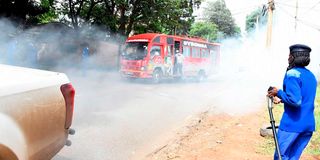Breaking News: At least 10 feared to have drowned in Makueni river
What you need to know about teargas and its health impacts

Police officers disperse rioters using teargas.
An irritating whiff of tear gas sneaks through a window at the Nation Centre following a loud bang of a fired canister along Kimathi Street.
The white smoke blinds everyone walking along the street. Protesters and bystanders duck covering their eyes.
The teargas canister has one job to do, one which is achieved at a stroke once it is let loose, but there is more than what meets the eye regarding its health impact.
What is a tear gas and what does it contain?
According to the Centres for Diseases Control and Prevention (CDC); tear gas is an anti-riot agent adopted by some countries like Kenya to control protestors.
It is one of the chemicals that was used during World War I to codon off rioters. Its use was however banned in 1993 during the Chemical Weapon Convention that happened in Geneva, Switzerland.
Contrary to its name, it is a chemical composed of solid and liquid particles and not gases. It is in powdered form but it creates a mist when let out.
Also read: Plea bargain and why it is in vogue
There are two major compounds found in a tear gas and they include; chloroacetophenone (CN) and chlorobenzylidenemalononitrile (CS).
How does it achieve its goal?
Tear gas can either be dispersed using hand-thrown grenades or canisters. According to Chemical Compound igniting a canister is the most common way to release tear gas.
Prof Janice Chambers explains to the Conversation that the chemicals contained in tear gas react with sensory nerve receptors once a person interacts with it.
This in turn leads to pain and skin irritation that escalates to the eyes and mucous membranes.
"They act almost instantly, but the irritation they induce is usually resolved in about 30 minutes to a few hours," she says.
Does it have health impacts on people?
There are short term and long term impacts of being exposed to tear gas.
Once a canister is fired, the immediate effect is an irritation that feels like a burning sensation to one’s eyes and skin.
The American Lung Association shows that it can also cause chest tightness, coughing, a choking sensation, wheezing and shortness of breath.
Other people may experience blurred vision and difficulty swallowing.
They explain that people with underlying diseases have even worse impacts when exposed to tear gas. People with asthma and chronic obstructive pulmonary disease (COPD), are more susceptible to developing severe symptoms of their disease which could lead to respiratory failure.
The chemicals also cause skin burns and allergic reactions.
The CDC shows that prolonged exposure, especially indoors, may lead to long-term effects such as eye problems including scarring, glaucoma, and cataracts.
Does it affect people the same way?
A person who gets exposed to tear gas indoors will not have the same impacts as the one who is outdoors.
A study conducted in the Journal of Royal Medicine Society dissecting the short and long term effects of the CS tears compound revealed that there’s limited data on its toxicology but its impact varies depending on the concentration.
They cite overuse and overexposure as a link to serious morbidity.
“In 1969 the British Home Office concluded that ‘whilst exposure to CS spray can be lethal in the form of toxic pulmonary damage, leading to pulmonary oedema’, such an occurrence would only occur at concentrations that were several hundred times greater than exposure dosage that produces intolerable symptoms which would force the individual to leave the vicinity,” they explain.
How can one protect themselves from negative health impacts of tear gas?
There is no known antidote backed by science that can clear and minimise tear gas’ irritation. Some people however use a solution of baking sodas and milk to wash it off.
The safest option, if you can, is to move further away from the area that has a high concentration of tear gas.
The CDC advises that you should remove the clothes that have been exposed to tear gas. Thereafter, wash parts of your skin that have come in contact with the chemicals using soap and water.
Soap may not be feasible during a riot, so water may suffice as a short term intervention. It is advisable that you rinse your eyes to wade off the irritation caused by the tear gas.
For people with respiratory issues, it is prudent to seek medical attention immediately so that you can get your oxygen levels improved from a healthcare facility.





